The Lenovo ThinkPad X1 Carbon Review (2015)
by Brett Howse on May 21, 2015 8:00 AM EST- Posted in
- Laptops
- Lenovo
- ThinkPad
- Ultrabook
- Broadwell-U
Display
Lenovo offers two display choices in the X1 Carbon, with a 1920x1080 model as the base option, and a 2560x1440 available with or without touch. While the resolution of the base panel is fine, the fact that it is a TN panel is not, so I would avoid that if at all possible. Thankfully the step up to the higher resolution model for $150 also gets you an IPS panel. With many devices that I see, there are some questionable decisions made, and I think the TN panel on a $1000+ Ultrabook is the one on this device.
Luckily Lenovo shipped the IPS panel for review. It is a 14-inch panel with a full RGB stripe. In the hardware ID the panel is just labeled as Lenovo, so I can’t say for sure who makes this panel. This model also has the touch digitizer. Despite that, it has almost a matte coating applied to it, or at least the anti-reflective coating is quite effective. This display also came with a built in ICC profile, so it was tested with that ICC being used.
To test the display characteristics, we use SpectraCal's CalMAN 5 suite along with the X-Rite i1Display Pro colorimeter for brightness and contrast readings, and the X-Rite i1Pro spectrophotometer for color accuracy testing.
Brightness and Contrast
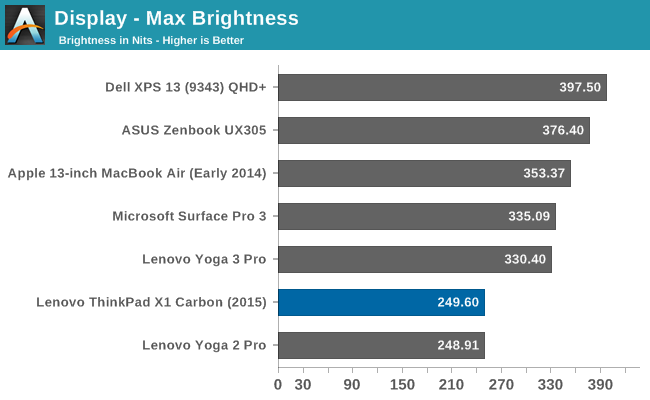
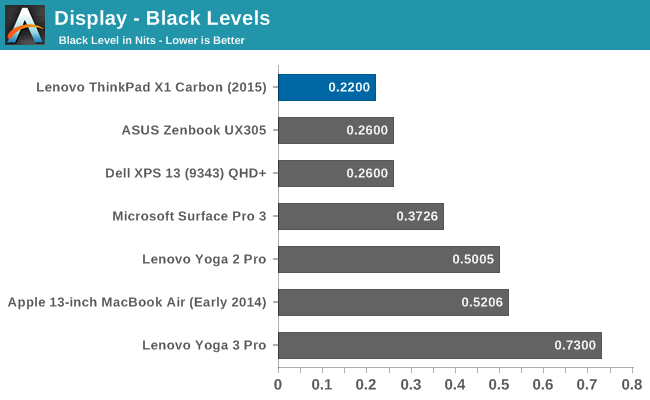
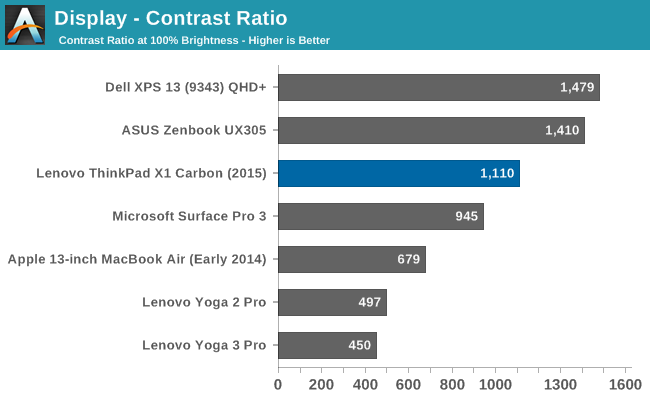
At 250 nits, the X1 Carbon does not get as bright as much of the competition. In fact, to do the color calibration steps, we set the display to 200 nits which is 92% in the power settings of this device. However black levels are quite good, so the overall contrast ratio is still a respectable 1100:1.
Grayscale
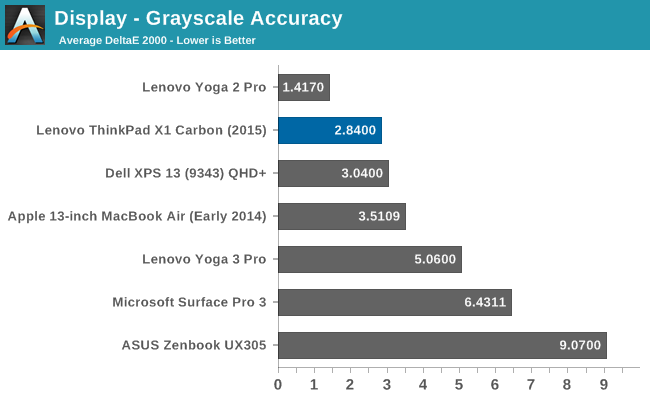
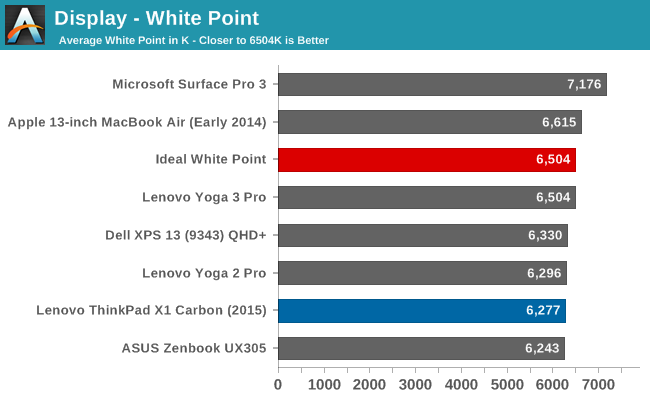
With an average score under three, the grayscale on the X1 Carbon is quite good. The errors do get a bit higher though as the brightness increases, and 100% white actually has a dE of over 5. Gamma drops down quite a bit at the higher brightness levels, and the overall gamma is just 2.0, and the target is 2.2.
Saturation

Saturation accuracy was decent on this display with an overall error level of 3.5, as an average over all of the readings. It is not the best display, but it is far from the worst. It is really the reds that drift off the most.
GMB
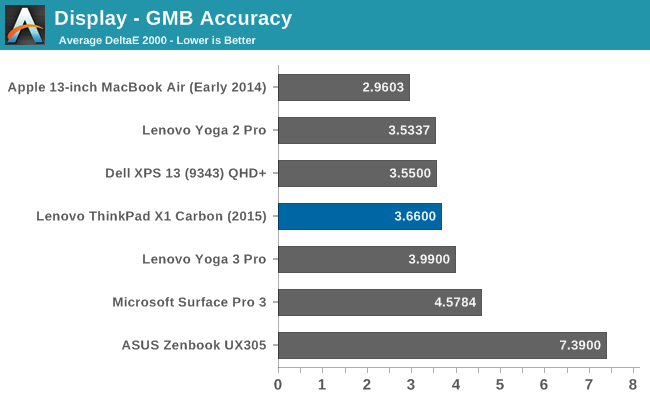
The Gretag Macbeth is the most comprehensive of the tests, and it tests quite a few colors including a lot of the flesh tones. The overall score is once again a good, but not great result, at 3.66.
The overall display is really just average, with no really standout features. The brightness is a bit low, but the contrast is good. Colors are off, but not dramatically. Out of curiosity, I also tested the display without the ICC profile as well, and surprisingly it did not have much of a change in the results. When a generic ICC profile is used, it can’t take into account variability in the individual panels.
Generally ICC profiles are the most help to grayscale, so I ran through our calibration to see how much we could improve the panel.
The grayscale sees a significant improvement, with a dE2000 of just 0.454 and gamma is almost spot on a 2.2. This is what calibration should do, so it was great to see the improvement. Unfortunately this only had a mild effect on the color related scores. Without a 3D LUT, there is only so much you can do.
One other thing that I need to mention about the display is that, at least on the sample I received, there was a bit of a twinkle in the display, which was more noticeable on light colors like white. All displays have a bit of this due to the glue and coatings applied, but on the X1 Carbon it was a bit more noticeable than I was used to.
So overall the display is just OK. Back in 2013 when the X1 Carbon first launched, a display of this quality would have been quite welcomed, but as with all things, progress moves forward and expectations get higher with the competition.

















103 Comments
View All Comments
der - Thursday, May 21, 2015 - link
ICC profile for your callibrated unit of this review?Noxxle - Thursday, May 21, 2015 - link
I'm also interested in the reviewer's calibrated profile. My X1's stock colors are too warm.Brett Howse - Thursday, May 21, 2015 - link
Let me see what I can do.Noxxle - Thursday, May 21, 2015 - link
Are the colors uniform across your x1's display? Specifically, I'd like to know if there is a yellowish tint more pronounced on one side.jvl - Thursday, May 21, 2015 - link
Wow, I'm really happy to see a 951 here. This should increase competition and push other manufactureres.I don't quite get why you compared with a MBA. In my opinion, things need to compete against the rMBP.
Damn I'm jealous of the SSD. Does my rMBP only feel slow...? ;-)
jvl - Thursday, May 21, 2015 - link
(On a side note, I hate capitalism. Competition by its very definition produces overhead and waste. If only an optimal planning apparatus existed to interface production with the market.. well I know.Let's go read Accelerando again)
Owls - Thursday, May 21, 2015 - link
You couldn't pay me any amount of money to use Lenovo. First and the biggest problem is their warranty work. It's slow, poorly executed, and extremely frustrating. Dell, by comparison, has turned their business around 100% and Lenovo should take note.BMNify - Thursday, May 21, 2015 - link
Warranty and service differs a lot from country to country, Dell may be wonderful in certain country but totally shit in another country, so please specify country name when you mention warranty and service experience.Gunbuster - Thursday, May 21, 2015 - link
Now if Dell would just let me customize a machine like the old days instead of picking from three options will all the wrong configuration for my needs.Hulk - Thursday, May 21, 2015 - link
When posting system performance can you also include a well known desktop so we can see performance relative to something most of us are familiar with performance-wise? A 4770k or something like that? Adding something older like a 2500k would be interesting too just to see if mobile CPUs are closing the gap at all from desktop parts of a few generations back.